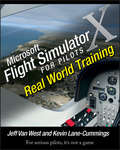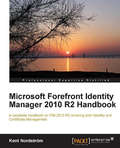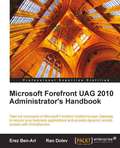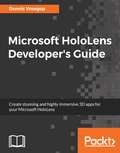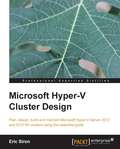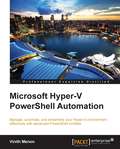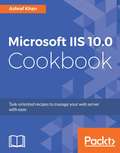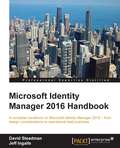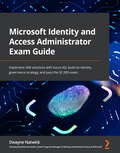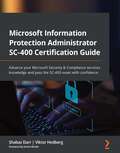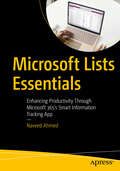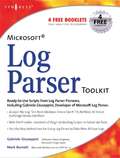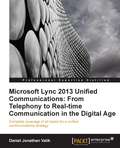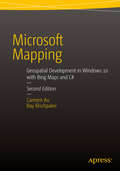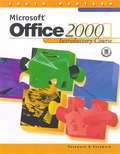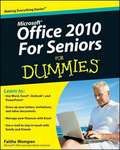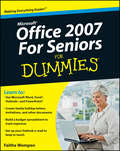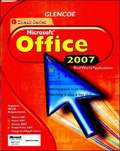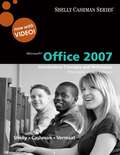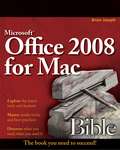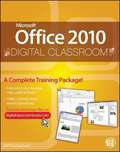- Table View
- List View
Microsoft Flight Simulator X for Pilots: Real-World Training
by Jeff Van West Kevin Lane-CummingsGet ready to take flight as two certified flight instructors guide you through the pilot ratings as it is done in the real world, starting with Sport Pilot training, then Private Pilot, followed by the Instrument Rating, Commercial Pilot, and Air Transport Pilot. They cover the skills of flight, how to master Flight Simulator, and how to use the software as a learning tool towards your pilot's license. More advanced topics demonstrate how Flight Simulator X can be used as a continuing learning tool and how to simulate real-world emergencies.
Microsoft Forefront Identity Manager 2010 R2 Handbook
by Kent NordströmThroughout the book, we will follow a fictional company, the case study will help you in implementing FIM 2010 R2. All the examples in the book will relate to this fictive company and you will be taken from design, to installation, to configuration of FIM 2010 R2. If you are implementing and managing FIM 2010 R2 in your business, then this book is for you. You will need to have a basic understanding of Microsoft based infrastructure using Active Directory. If you are new to Forefront Identity Management, the case-study approach of this book will help you to understand the concepts and implement them.
Microsoft Forefront UAG 2010 Administrator's Handbook
by Ran Dolev Erez Ben-AriThis book is a hands-on guide, describing concepts, ideas and terminology related to UAG and related technologies. The book starts with a discussion of terms that UAG technology is based on, and proceeds with step-by-step guidance for performing the various tasks related to UAG's core features. Each topic is preceded by a discussion of considerations that the administrator and the organization needs to go through to prepare for the task at hand, and includes plenty of screenshots illustrating what the administrator should expect to see on-screen, with real-life examples of configuration options.If you are a Networking or Security engineer who intends to integrate UAG into the organization network, then this book is for you. You need no experience with UAG or its predecessors, though basic understanding of Networking and Windows Server management and engineering is required. Experience with security systems like Firewalls would also help you to better understand some of the topics covered by this book.
Microsoft HoloLens Developer's Guide
by Dennis VroegopTransform the ways you communicate, create, collaborate, and explore using Microsoft HoloLens About This Book • Create immersive augmented reality apps for Microsoft HoloLens from scratch • Leverage the powerful HoloLens sensors to interact with real-world motions and gestures and make your app life-like • Explore the powerful Unity 5 SDK along with the Windows Unified platform to get the most out of your HoloLens app Who This Book Is For If you are a developer who wants to create augmented reality apps for the Microsoft HoloLens platform, then this is the book for you. Coding experience with C# is assumed. What You Will Learn • Design an app for HoloLens that is feasible and attractive to use • Add gestures and interact with them • Create sounds in the app and place them in a 3D space • Use voice generation and voice recognition to make your apps more lifelike • Interact with the physical environment to place holograms on top of physical objects • Compare HoloLens with the other products and know how to use its strengths • Use assets from third parties to enrich our app In Detail HoloLens, Microsoft's innovative augmented reality headset, overlaps holograms into a user's vision of their environment. Your ideas are closer to becoming real when you can create and work with holograms in relation to the world around you. If you are dreaming beyond virtual worlds, beyond screens, beyond pixels, and want to take a big leap in the world of augmented reality, then this is the book you want. Starting off with brainstorming and the design process, you will take your first steps in creating your application for HoloLens. You will learn to add gestures and write an app that responds to verbal commands before gradually moving on creating sounds in the app and placing them in a 3D space. You will then communicate between devices in the boundaries of the UWP model. Style and approach This book takes a step-by-step, practical, tutorial-style approach where you will dive deep into HoloLens app development. You will work with the API and write your own complex scripts that would interact with the powerful HoloLens sensors and with realistic examples, you will be able to create immersive 3D apps for HoloLens.
Microsoft Hyper-V Cluster Design
by Eric SironThis book is written in a friendly and practical style with numerous tutorials centred on common as well as atypical Hyper-V cluster designs. This book also features a sample cluster design throughout to help you learn how to design a Hyper-V in a real-world scenario.Microsoft Hyper-V Cluster Design is perfect for the systems administrator who has a good understanding of Windows Server in an Active Directory domain and is ready to expand into a highly available virtualized environment. It only expects that you will be familiar with basic hypervisor terminology.
Microsoft Hyper-V PowerShell Automation
by Vinith MenonThis book is great for administrators who are new to automating Hyper-V administration tasks using PowerShell. If you are familiar with the PowerShell command line and have some experience with the Windows Server, this book is perfect for you.
Microsoft IIS 10.0 Cookbook
by Ashraf KhanOver 60 recipes to install, configure, and manage your IIS 10.0 About This Book • Provide a secure, easy-to-manage extensible platform for hosting your websites • Leverage IIS 10.0 in order to deploy web site in seconds • Integrate Windows and Nano Server 2016 and automate it with PowerShell • Recipes to Manage and monitor your IIS 10.0 Who This Book Is For If you are an administrator or web developer with a basic (or no) knowledge of Microsoft IIS and want to set up your own web server, then this is the book for you. What You Will Learn • Integrate IIS 10.0 on Windows server 2016 • Host multiple websites and Wildcard Host on IIS 10.0 • Deploy and administrate IIS 10.0 on Nano Server. • IIS administration with Powershell. • Manage and troubleshoot IIS 10.0 In Detail This book will start with customizing your IIS 10 to various platforms/OS and tune it according to your business requirements. Moving on, we will focus on the functionalities of core fundamentals and perform practical scenarios in order to maximize the use of a reliable web server. Going further we will be covering topics like IIS 10 architecture, IIS modules,hosting web server platforms, virtual directories along with web site deployment, ports, enhanced security. We will also cover new features of IIS 10 like integration with Windows Server 2016 and Nano Server, HTTP/2, PowerShell 5 cmdlets etc . Towards the end, we will cover troubleshooting & diagnostic techniques of IIS 10. By the end of this book you will be well versed with maximizing the reliability of your webserver and will have immense knowledge in using IIS 10 effectively Style and approach A set of exciting recipes on using Microsoft IIS 10.0 effectively..
Microsoft Identity Manager 2016 Handbook
by Jeff Ingalls David SteadmanA complete handbook on Microsoft Identity Manager 2016 - from design considerations to operational best practices About This Book * Get to grips with the basics of identity management and get acquainted with the MIM components and functionalities * Discover the newly-introduced product features and how they can help your organization * A step-by-step guide to enhance your foundational skills in using Microsoft Identity Manager from those who have taught and supported large and small enterprise customers Who This Book Is For If you are an architect or a developer who wants to deploy, manage, and operate Microsoft Identity Manager 2016, then this book is for you. This book will also help the technical decision makers who want to improve their knowledge of Microsoft Identity Manager 2016. A basic understanding of Microsoft-based infrastructure using Active Directory is expected. Identity management beginners and experts alike will be able to apply the examples and scenarios to solve real-world customer problems. What You Will Learn * Install MIM components * Find out about the MIM synchronization, its configuration settings, and advantages * Get to grips with the MIM service capabilities and develop custom activities * Use the MIM Portal to provision and manage an account * Mitigate access escalation and lateral movement risks using privileged access management * Configure client certificate management and its detailed permission model * Troubleshoot MIM components by enabling logging and reviewing logs * Back up and restore the MIM 2015 configuration * Discover more about periodic purging and the coding best practices In Detail Microsoft Identity Manager 2016 is Microsoft's solution to identity management. When fully installed, the product utilizes SQL, SharePoint, IIS, web services, the .NET Framework, and SCSM to name a few, allowing it to be customized to meet nearly every business requirement. The book is divided into 15 chapters and begins with an overview of the product, what it does, and what it does not do. To better understand the concepts in MIM, we introduce a fictitious company and their problems and goals, then build an identity solutions to fit those goals. Over the course of this book, we cover topics such as MIM installation and configuration, user and group management options, self-service solutions, role-based access control, reducing security threats, and finally operational troubleshooting and best practices. By the end of this book, you will have gained the necessary skills to deploy, manage and operate Microsoft Identity Manager 2016 to meet your business requirements and solve real-world customer problems. Style and approach The concepts in the book are explained and illustrated with the help of screenshots as much as possible. We strive for readability and provide you with step-by-step instructions on the installation, configuration, and operation of the product. Throughout the book, you will be provided on-the-field knowledge that you won't get from whitepapers and help files.
Microsoft Identity and Access Administrator Exam Guide: Implement IAM solutions with Azure AD, build an identity governance strategy, and pass the SC-300 exam
by Dwayne Natwick Shannon KuehnThis certification guide focuses on identity solutions and strategies that will help you prepare for Microsoft Identity and Access Administrator certification, while enabling you to implement what you've learned in real-world scenariosKey FeaturesDesign, implement, and operate identity and access management systems using Azure ADProvide secure authentication and authorization access to enterprise applicationsImplement access and authentication for cloud-only and hybrid infrastructuresBook DescriptionCloud technologies have made identity and access the new control plane for securing data. Without proper planning and discipline in deploying, monitoring, and managing identity and access for users, administrators, and guests, you may be compromising your infrastructure and data. This book is a preparation guide that covers all the objectives of the SC-300 exam, while teaching you about the identity and access services that are available from Microsoft and preparing you for real-world challenges.The book starts with an overview of the SC-300 exam and helps you understand identity and access management. As you progress to the implementation of IAM solutions, you'll learn to deploy secure identity and access within Microsoft 365 and Azure Active Directory. The book will take you from legacy on-premises identity solutions to modern and password-less authentication solutions that provide high-level security for identity and access. You'll focus on implementing access and authentication for cloud-only and hybrid infrastructures as well as understand how to protect them using the principles of zero trust. The book also features mock tests toward the end to help you prepare effectively for the exam.By the end of this book, you'll have learned how to plan, deploy, and manage identity and access solutions for Microsoft and hybrid infrastructures.What you will learnUnderstand core exam objectives to pass the SC-300 examImplement an identity management solution with MS Azure ADManage identity with multi-factor authentication (MFA), conditional access, and identity protectionDesign, implement, and monitor the integration of enterprise apps for Single Sign-On (SSO)Add apps to your identity and access solution with app registrationDesign and implement identity governance for your identity solutionWho this book is forThis book is for cloud security engineers, Microsoft 365 administrators, Microsoft 365 users, Microsoft 365 identity administrators, and anyone who wants to learn identity and access management and gain SC-300 certification. You should have a basic understanding of the fundamental services within Microsoft 365 and Azure Active Directory before getting started with this Microsoft book.
Microsoft Information Protection Administrator SC-400 Certification Guide: Advance your Microsoft Security & Compliance services knowledge and pass the SC-400 exam with confidence
by Shabaz Darr Viktor HedbergDiscover how to implement information protection, data loss prevention, and information governance within Microsoft 365Key FeaturesDesign, implement, and administer Microsoft Information ProtectionImplement data loss prevention to minimize the risk of data exfiltrationUse Information Governance capabilities to ensure that data is stored in your environment for as long as necessaryBook DescriptionCloud technologies have massively increased the amount of data being produced and the places in which this data is stored. Without proper planning and discipline in configuring information protection for your data, you may be compromising information and regulatory compliance.Microsoft Information Protection Administrator SC-400 Certification Guide begins with an overview of the SC-400 exam, and then enables you to envision, implement, and administer the Information Protection suite offered by Microsoft. The book also provides you with hands-on labs, along with the theory of creating policies and rules for content classification, data loss prevention, governance, and protection. Toward the end, you'll be able to take mock tests to help you prepare effectively for the exam.By the end of this Microsoft book, you'll have covered everything needed to pass the SC-400 certification exam, and have a handy, on-the-job desktop reference guide.What you will learnUnderstand core exam objectives to pass the SC-400 exam with easeFind out how to create and manage sensitive information types for different types of dataCreate and manage policies and learn how to apply these to Microsoft 365 SaaS applicationsBroaden your knowledge of data protection on M365Discover how to configure and manage the protection of your data in M365Monitor activity regarding data access in M365Understand and implement Data Governance in M365Who this book is forIf you are a compliance administrator, Microsoft 365 Administrator, or Information Protection Administrator who wants to improve their knowledge of Microsoft Security & Compliance services, then this book is for you. This book is also ideal for anyone looking to achieve the SC-400 Information Protection Associate Administrator certification.
Microsoft Lists Essentials: Enhancing Productivity Through Microsoft 365's Smart Information Tracking App
by Naveed AhmedUnlock the full potential of Microsoft Lists, an indispensable tool within the Microsoft 365 suite for tracking and organizing information. This book is your comprehensive guide, from the fundamentals to the advanced capabilities of Microsoft Lists, and will help you improve productivity and foster collaboration. Whether you’re making a basic to-do list or managing a complex inventory system, Lists is built for a broad spectrum of users, from beginners to professionals, catering to diverse enterprise and consumer use cases. The book provides thorough coverage of a wide array of topics, from the history of the product and initial setup to the entire set of features it offers. Insights are presented on using templates, optimizing columns, managing your lists, mastering the views, JSON features, and the various sharing and collaboration tools to utilize the product for maximum productivity. The book includes the latest features, such as commenting, Lists forms, real-time presence, and an in-depth look at the mobile experience. This guidebook is designed to transform your approach to information tracking and management. It offers practical examples, scenarios, and step-by-step instructions, complemented by rich visuals. The book is ideal for enterprises seeking to boost team productivity and also for individuals who wish to manage information with friends and family. What You Will Learn Optimize information management and manage lists like a pro, with list templates, custom columns, views, and JSON customization Boost collaboration through sharing and commenting, and by employing Microsoft's security and privacy features Maintain productivity on the go by navigating and managing lists on mobile devices, keeping your information accessible anywhere Enhance productivity by connecting Microsoft Lists with other products in the Microsoft 365 ecosystem Who This Book Is For Business professionals. IT administrators, and individuals keen on leveraging Microsoft Lists within the Microsoft 365 ecosystem
Microsoft Log Parser Toolkit
by Gabriele GiuseppiniDo you want to find Brute Force Attacks against your Exchange Server? Would you like to know who is spamming you? Do you need to monitor the performance of your IIS Server? Are there intruders out there you would like to find? Would you like to build user logon reports from your Windows Server? Would you like to export your logs to XML? Would you like working scripts to automate all of these tasks and many more for you? If so, this book is for you... "Microsoft Log Parser Toolkit" is co-authored by Microsoft's Log Parser developer providing a complete reference to this SQL-Query driven log analysis tool. The book and accompanying Web site also provide dozens of customized, working scripts, queries, and templates for Windows Server, Snort IDS, Exchange Server, IIS, ISA Server, Snort and more.
Microsoft Lync 2013 Unified Communications: From Telephony to Real-Time Communication in the Digital Age
by Daniel Jonathan ValikThis is a tutorial guide to gain in-depth knowledge such as realizing projects to migrate traditional telephony to Unified Communications inside an organization.This book is targeted at three audiences: business decision makers, technical advocates, and IT decision makers. As this is also a fundamental book on real time collaboration technology, it is also suitable for anyone who is interested in the future of communications.
Microsoft Mapping
by Ray Rischpater Carmen AuGeospatial mapping applications have become hugely popular in recent years. With smart-phone and tablet numbers snow-balling this trend looks set to continue well into the future. Indeed, it is true to say that in today s mobile world location-aware apps are becoming the norm rather than the exception. In Microsoft Mapping author Ray Rischpater showcases Microsoft's Bing Maps API and demonstrates how its integration features make it by far the strongest mapping candidate for business that are already using Windows 8 or the . NET Framework. Whether you want to build a new app from scratch of add a few modest geospatial features to your existing website Ray's carefully chosen examples will provide you with both the inspiration and the code you need to achieve your goals. "
Microsoft Office 2000: Introductory Course
by William R. Pasewark Sr. William R. Pasewark Jr.This comprehensive text offers a thorough introduction to the four main Microsoft Office 2000 applications plus Outlook. The coverage of Word and Excel provide Proficient level certification for the Microsoft Office User Specialist (MOUS) certification program.
Microsoft Office 2007 For Seniors For Dummies
by Faithe WempenSeniors who are new to computers can learn Office applications quickly and easily If you're over 50 and new to computers, everything about them can seem intimidating. The most common applications you'll want to use are part of the Microsoft Office suite - Word, Excel, PowerPoint, and Outlook. Microsoft Office 2007 For Seniors For Dummies shows you how to use each one in a straightforward, fun manner that takes all the apprehension away. This plain-English guide shows you just what you need to know to write letters with Word, keep a budget with an Excel spreadsheet, create fun slideshows with PowerPoint, and set up an e-mail account using Outlook. Microsoft Office 2007 For Seniors For Dummies doesn't assume you were born knowing how to use a computer; it starts at the beginning and makes learning easy and quick. Each chapter lists the tasks covered, with page references to help you locate what you need Shows how to start each application and navigate the elements on the screen Covers how to create documents in Word and provides templates for letters and faxes Explains how to create spreadsheets and includes a grid for budgeting Guides you through creating a PowerPoint presentation Demonstrates how to set up an e-mail account with Outlook and communicate with others Microsoft Office 2007 For Seniors For Dummies will have you using basic Office applications in no time, and boost your confidence too.
Microsoft Office 2007 For Seniors For Dummies
by Faithe WempenSeniors who are new to computers can learn Office applications quickly and easily If you're over 50 and new to computers, everything about them can seem intimidating. The most common applications you'll want to use are part of the Microsoft Office suite - Word, Excel, PowerPoint, and Outlook. Microsoft Office 2007 For Seniors For Dummies shows you how to use each one in a straightforward, fun manner that takes all the apprehension away. This plain-English guide shows you just what you need to know to write letters with Word, keep a budget with an Excel spreadsheet, create fun slideshows with PowerPoint, and set up an e-mail account using Outlook. Microsoft Office 2007 For Seniors For Dummies doesn't assume you were born knowing how to use a computer; it starts at the beginning and makes learning easy and quick. Each chapter lists the tasks covered, with page references to help you locate what you need Shows how to start each application and navigate the elements on the screen Covers how to create documents in Word and provides templates for letters and faxes Explains how to create spreadsheets and includes a grid for budgeting Guides you through creating a PowerPoint presentation Demonstrates how to set up an e-mail account with Outlook and communicate with others Microsoft Office 2007 For Seniors For Dummies will have you using basic Office applications in no time, and boost your confidence too.
Microsoft Office 2007, Real World Applications
by C. Jacqueline Schultz Linda WooldridgeiCheck Microsoft Office 2007is an engaging top-bound text which provides students with applications that apply to everyday life! Written specifically for high school students, this rigorous series provides extensive step-by-step exercises and projects that prepare students for MCAS certification. It is age-level and interest-level appropriate. The student edition includes integration of basic language arts and mathematics skills.
Microsoft Office 2007: Introductory Concepts and Techniques
by Gary B. Shelly Thomas J. Cashman Misty E. VermaatThis book is intended for a first course on Office 2007 applications and to expose students to practical examples of the computer, to acquaint students with the proper procedures to create documents, worksheets through an exercise-oriented approach.
Microsoft Office 2008 for Mac Bible
by Greg Kettell Sherry Kinkoph Gunter Jennifer Ackerman KettellWritten by an expert in the field of technology training and author of nearly two dozen titles, this complete guide offers readers thorough yet clear instruction on using the Microsoft Office suite: Word, Excel, PowerPoint, and EntourageApple has welcomed Microsoft Office into its world and this reference is the ultimate resource for learning how to best capitalize on each application of OfficeReviews creating, editing, formatting, and sharing digital documents with Word; gathering and analyzing information with Excel; creating dynamic presentations with PowerPoint; and using the e-mail and calendar of Entourage
Microsoft Office 2010
by Audrey Rutkosky Roggenkamp Denise Seguin Nita RutkoskyNIMAC-sourced textbook
Microsoft Office 2010
by Audrey Rutkosky Roggenkamp Denise Seguin Nita RutkoskyMarquee Series, Microsoft Office 2010 prepares students to work with Microsoft Office 2010 in a business office or for personal use. Incorporating an accelerated, step-by-step, project-based approach, this text builds student competency in Word, Excel, Access, and PowerPoint 2010 and the essential features of Windows 7 and Internet Explorer 8.0.
Microsoft Office 2010 Digital Classroom
by Agi Training TeamThe complete book-and-video training package for Office 2010! This Microsoft Office 2010 book-and-video training package-from the same professional training experts who also create many training materials for Microsoft-is like having your own personal instructor guiding you through each lesson, but you work at your own pace! The full-color book includes 27 lessons that teach you the new features and quirks of Microsoft Office 2010. Each lesson includes step-by-step instructions and lesson files, and provides valuable video tutorials that complement what you're learning and clearly demonstrate how to do tasks. This jam-packed training package takes you well beyond the basics in a series of easy-to-absorb, five-minute lessons. Shows you how to use Microsoft Office 2010, the new version of the Microsoft Office suite that is available in standard 32-bit and now also a 64-bit version Walks you through 27 lessons, each consisting of easy-to-follow, step-by-step instructions and lesson files in full color that make each task less intimidating Includes all the lesson files from the book and video tutorials that clearly show you how to do tasks and reinforces what you're learning in the book Covers exciting new Office 2010 features such as Office Web apps that can be accessed from anywhere and a streamlined new Ribbon Provides the perfect, one-stop, robust learning package-with book and supplementary video training on all the applications in Office 2010 Additional resources available on companion Web site: www. digitalclassroombooks. com Learn the ins-and-outs of Office 2010 with this all-in-one, value-packed combo!
Microsoft Office 2010 Illustrated First Course Introductory
by Jennifer Duffy Lisa Friedrichsen Elizabeth Eisner Reding Carol M. Cram David W. BeskeenLoved by instructors for its visual and flexible way to build computer skills, the Illustrated Series is ideal for teaching Microsoft Office 2010 to both computer rookies and hotshots. Each two-page spread focuses on a single skill, making information easy to follow and absorb. Large, full-color illustrations represent how the students' screen should look. Concise text introduces the basic principles of the lesson and integrates a case study for further application.
